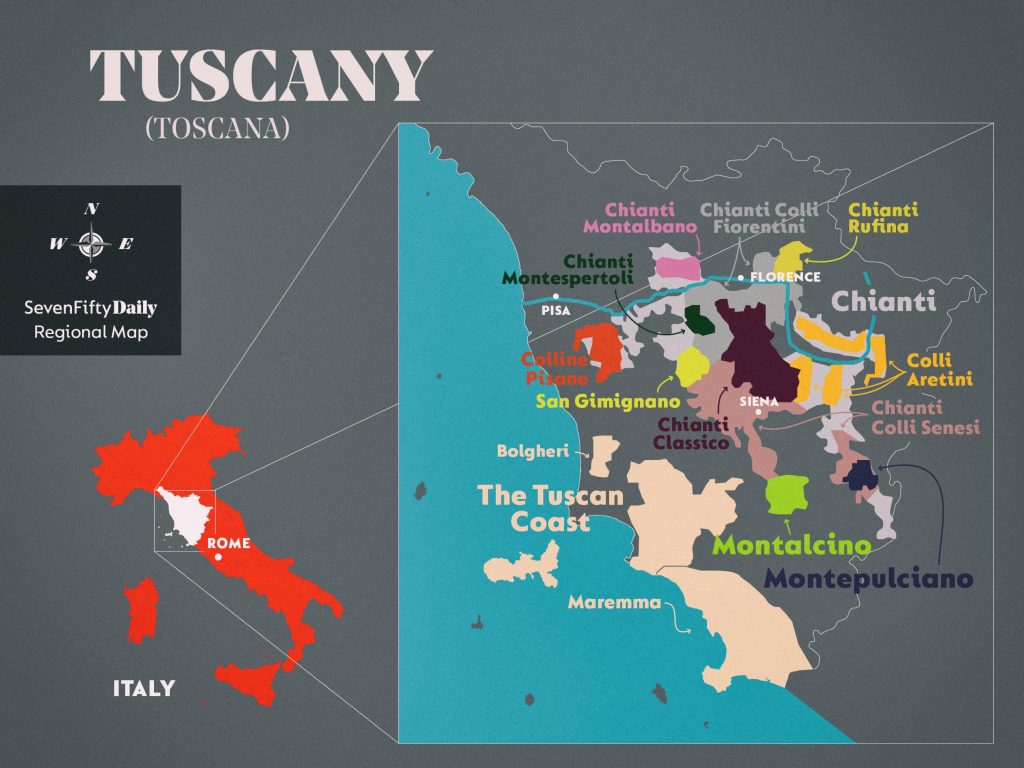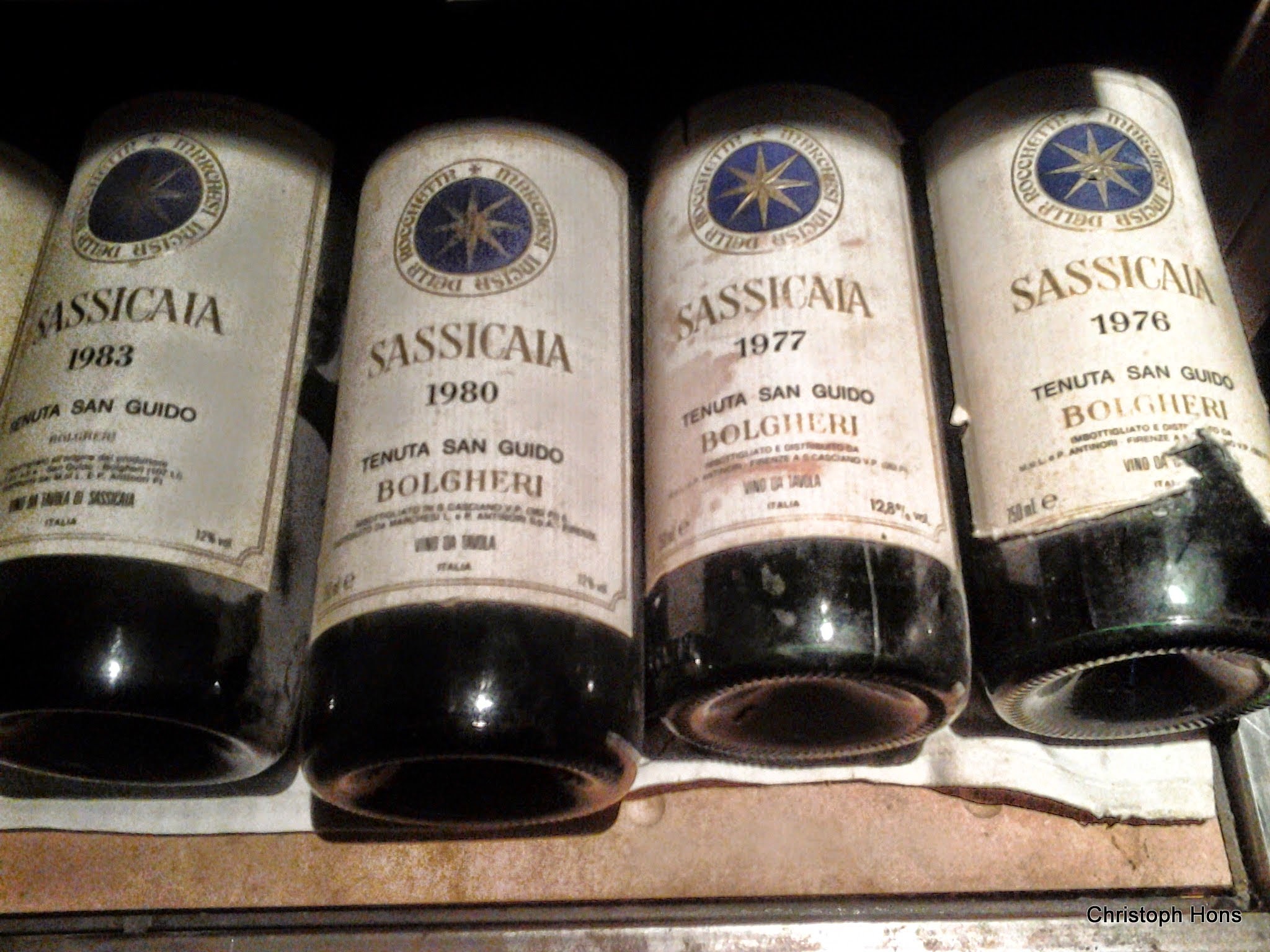Few wines carry the aura of myth like Sassicaia. Born in Bolgheri from the vision of Marchese Mario Incisa della Rocchetta, it began as an experiment in the 1940s when he planted Cabernet Sauvignon and Cabernet Franc on gravelly soils more reminiscent of Graves than Tuscany. For decades, the wine was made only for family and friends. Then came the 1968 commercial release, and Sassicaia was unveiled to the world. It broke every Italian rulebook yet went on to rewrite them, earning Bolgheri its own DOC in 1994 — the only appellation in Italy created because of a single wine.
Sassicaia is not just a wine; it is a diary of Bolgheri itself — a record of sun, rain, wind, vineyard decisions, and winemaking choices, written vintage by vintage. The following chronicle traces every year from 1968 to 2022, blending harvest conditions, stylistic character, cellar decisions, and tasting expression into a living narrative.

1968–1970s: The Foundational Years
1968 – The first commercial release emerged from a balanced season. Warm days and cool nights allowed the Cabernet Sauvignon and Cabernet Franc to ripen slowly. Oak aging began in a mix of new and used French barrels, setting the stylistic foundation for the estate. The wine revealed cedar, tobacco, and dried cherry, elegant yet undeniably powerful, establishing Sassicaia’s identity.
1969 – A cooler, uneven growing season created a lighter wine. The winemakers made careful sorting decisions to maintain fruit quality. Red currants, green pepper, and savory herb notes marked a Sassicaia that leaned toward finesse rather than richness.
1970 – Warm summer sun produced a richer vintage, with blackberry and plum accented by earthy tones. Cellar decisions emphasized gentle extraction, preserving structure and hinting at Bolgheri’s potential.
1971 – A challenging, cool year led to a more ethereal Sassicaia, with bright red currants, wild herbs, and a saline lift. The oak regimen was conservative, focusing on integration over influence.
1972–1974 – Variable weather created wines ranging from lean and delicate to modestly firm. Persistent rain required selective harvest and sorting, yielding notes of cherry, cedar, underbrush, and tomato leaf, demonstrating the vineyard’s ability to produce honest wines even in difficult years.
1975 – Hot, dry conditions produced robust blackcurrant, leather, and truffle flavors. Fermentation was carefully monitored to avoid excessive extraction, resulting in a rustic but confident wine.
1976–1979 – Cooler and wetter years alternated with warmer ones. Sassicaia varied from lean and herbal to concentrated and balanced, with meticulous vineyard selection and early experimentation in barrel aging defining the house style.



1980s: The Rise of the Super Tuscan Movement
The 1980s saw Sassicaia gain international acclaim, inspiring other Tuscan producers to experiment with international varieties, ultimately challenging Italy’s traditional DOC regulations. The term “Super Tuscan” became synonymous with quality and innovation, though initially unofficial.
1980–1981 – Leaner, more acidic vintages with cassis, cedar, and firm tannins. Cellar teams focused on precision in maceration and gentle pressing.
1982–1983 – Excellent weather produced rich, polished wines. Ripe fruit, tobacco, and spice emerged, with oak aging refined to balance flavor and structure.
1984 – Challenging conditions yielded thin, herbal wines. These vintages highlighted the importance of meticulous sorting in the vineyard.
1985 – A legendary year. Warm days, tempered by coastal breezes, created cassis, violets, graphite, and sweet spice. Tannins were silken, oak was fully integrated, and the finish stretched endlessly, establishing Sassicaia as a benchmark for Italian wine.
1986–1989 – These vintages varied from solid and robust to lean and herbal. Winemaking decisions focused on consistency and aging potential, experimenting with blending minor proportions of Cabernet Franc to enhance aromatic complexity.
1990s: DOC Recognition and Refinement
Sassicaia’s growing influence led to the creation of the Bolgheri Sassicaia DOC in 1994, the first Italian DOC awarded to a single wine. This recognition formalized its quality, enabling further refinement in vineyard management and winemaking techniques.
1990–1991 – Warm vintages produced rich blackberries and plums, balanced by balsamic herbs. Cool years yielded lighter, more herbal wines. Decisions on harvest timing and oak selection were crucial to preserving freshness.
1992–1994 – Rain and cool conditions demanded rigorous sorting. Resulting wines ranged from lighter, saline-tinged expressions (1994) to balanced classics (1993).
1995–1999 – These vintages saw fine-tuning of fermentation and oak aging practices. Polished tannins, cassis, graphite, and floral notes emerged, demonstrating consistent quality and building Sassicaia’s modern identity.
2000s: Modernization and Technical Innovation
The new millennium brought temperature-controlled fermentation, improved cellar technology, and greater precision in blending decisions. Oak aging evolved to optimize integration without overpowering fruit.
2000–2004 – Ripe, expressive fruit combined with polished tannins. Stylistic choices emphasized elegance, with selective new oak barrels balancing power and refinement.
2005–2009 – Cool, late-harvested years required patience, while warm vintages delivered lush, opulent fruit. Meticulous vineyard monitoring ensured consistency, and the core blend of ~85% Cabernet Sauvignon and 15% Cabernet Franc remained foundational.
2010s: Sustainability, Precision, and Global Legacy
Sustainability became central. Practices included organic farming methods, careful water management, and energy-efficient production. Precision viticulture enabled detailed tracking of vineyard blocks to harvest at optimal ripeness.
2010–2015 – Cooler, long-ripening vintages produced taut, architectural wines with cassis, olive, and crushed stone, while warmer vintages offered opulent black fruit and violet notes. Oak aging continued in French barrels for 24 months, refined to balance structure and flavor.
2016–2019 – The estate embraced data-driven decisions in harvest timing and maceration. Vintages ranged from youthful elegance (2018) to warm-powerful styles (2017), with consistent attention to tannin refinement and aromatic layering.
2020s: Legacy and Forward Vision
Even amid global challenges, Bolgheri vineyards thrived. Harvest decisions focused on maintaining equilibrium, preserving minerality and freshness, and reflecting the maritime influence of the region.
2020–2022 – Dark fruit, cocoa, sage, graphite, and saline minerality emerged. Tannins were polished and integrated, reflecting both the house’s signature style and the careful adaptation to modern viticulture challenges. Each vintage continues to honor Sassicaia’s legacy while embracing the precision, sustainability, and elegance expected of a contemporary classic.
